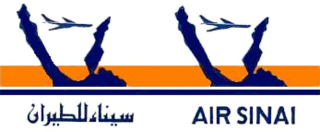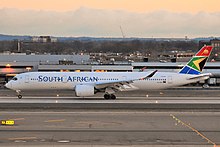
An airline is a company that provides air transport services for traveling passengers and/or freight. Airlines use aircraft to supply these services and may form partnerships or alliances with other airlines for codeshare agreements, in which they both offer and operate the same flight. Generally, airline companies are recognized with an air operating certificate or license issued by a governmental aviation body. Airlines may be scheduled or charter operators.
Kenya Airways Ltd., more commonly known as Kenya Airways, is the flag carrier airline of Kenya. The company was founded in 1977, after the dissolution of East African Airways. Its head office is located in Embakasi, Nairobi, with its hub at Jomo Kenyatta International Airport.

Libyan Airlines, formerly known as Libyan Arab Airlines over several decades, is the flag carrier of Libya. Based in Tripoli, it operates scheduled passenger and cargo services within Libya and to Europe, North Africa and the Middle East, the majority of which leave from Tripoli International Airport. Benina International Airport in Benghazi serves as a secondary base. Libyan Airlines also operates Hajj services. The company is wholly owned by the government of Libya.
Egyptair is the state-owned flag carrier of Egypt. The airline is headquartered at Cairo International Airport, its main hub, operating scheduled passenger and freight services to 81 destinations in Africa, Europe, Asia, and The Americas. Egyptair is a member of Star Alliance.

Ethiopian Airlines, formerly Ethiopian Air Lines (EAL), is the flag carrier of Ethiopia, and is wholly owned by the country's government. EAL was founded on 21 December 1945 and commenced operations on 8 April 1946, expanding to international flights in 1951. The firm became a share company in 1965 and changed its name from Ethiopian Air Lines to Ethiopian Airlines.

Ghana Airways Limited was the flag carrier of Ghana, with its main base of operation and hub at Kotoka International Airport in Accra. The airline ceased operations in 2004, although plans were discussed to revive it in 2020 in partnership with Egyptair.
Air Tanzania Company Limited (ATCL) (Swahili: Kampuni ya Ndege ya Tanzania) is the flag carrier airline of Tanzania. It is based in Dar es Salaam, with its hub at Julius Nyerere International Airport.

Air Sinai was an airline based in Cairo, Egypt. It operated as a 'paper airline' for parent company Egyptair under a wet lease-like agreement to serve flights exclusively between Egypt and Israel.

Cairo International Airport is the principal international airport of Cairo and the largest and busiest airport in Egypt. It serves as the primary hub for Egyptair and Nile Air as well as several other airlines. The airport is located in Heliopolis, to the northeast of Cairo around fifteen kilometres from the business area of the city and has an area of approximately 37 km2 (14 sq mi). It is the busiest airport in Africa, in terms of total passengers.

Air Djibouti, also known as Red Sea Airlines, is the flag carrier of Djibouti. It first flew in 1963 and ceased all operations in 2002. In 2015, the airline was relaunched, first as a cargo airline and then, in 2016, with passenger services as well. It is headquartered in the capital, Djibouti.
Air Mauritanie was the national airline of Mauritania from 1962 until it ceased operations in 2007 due to financial difficulties. It was based at Nouakchott International Airport, from where it operated domestic services, as well as flights to African destinations and Paris. The carrier had its headquarters in Nouakchott.

LAM - Mozambique Airlines, S. A. or Linhas Aéreas de Moçambique, Ltd., operating as LAM Mozambique Airlines, is the flag carrier of Mozambique. The airline was established by the Portuguese colonial government of Mozambique in August 1936 as a charter carrier named DETA - Direcção de Exploração de Transportes Aéreos, and was renamed in 1980 following reorganisation. LAM Mozambique Airlines is based in Maputo, and has its hub at Maputo International Airport. It operates scheduled services in Southern Africa. The company is a member of the International Air Transport Association, and of the African Airlines Association since 1976.

Uganda Airlines was the flag carrier of Uganda. The airline was established in May 1976, and started operations in 1977. It was headquartered in Entebbe, Wakiso District, Uganda, and operated from its hub in Entebbe International Airport.

Somali Airlines was the flag carrier of Somalia. Established in 1964, it offered flights to both domestic and international destinations. It operated Boeing 720Bs, Boeing 707-300s and Airbus A310-300s on a network to the Middle East and Europe. The airline discontinued operations after the start of the civil war in the early 1990s, when the country fell into anarchy. A reconstituted Somali government later began preparations in 2012 for an expected relaunch of the carrier, with the first new Somali Airlines aircraft scheduled for delivery by the end of December 2013.

Nigeria Airways Ltd., more commonly known as Nigeria Airways, was a Nigerian airline. The company was founded in 1958 after the dissolution of West African Airways Corporation (WAAC). It held the name West African Airways Corporation Nigeria until 1971, when it was rebranded to the name it had until it ceased operations in 2003. The government of Nigeria owned a majority of the airline (51%) until 1961, when it boosted its shareholding in the company to 100% and made it the country's flag carrier. At the time of dissolution, the airline's headquarters were at Airways House in Abuja. Operations were concentrated at Murtala Muhammed International Airport and served both domestic and international destinations mainly concentrated in West Africa; the network also had points in Europe, North America and Saudi Arabia. The airline was managed by a number of foreign companies, including British Airways, KLM and South African Airways.

Kenneth Kaunda International Airport is an international airport located in Chongwe District, off the Great East Road, approximately 27 kilometres (17 mi) northeast of the city centre of Lusaka, the capital and largest city of Zambia. The airport has a capacity of 6 million and is the largest in Zambia, serving as a hub for its region. The airport serves as a hub for Zambia Airways, Proflight Zambia, Royal Zambian Airlines, and Mahogany Air.
East African Airways Corporation, more commonly known as East African Airways, was an airline jointly run by Kenya, Tanzania, and Uganda. It was set up on 1 January 1946, starting operations the same year. The airline was headquartered in the Sadler House in Nairobi, Kenya. The corporation was dissolved in 1977 amid deteriorated relations among the three countries.
West African Airways Corporation, or WAAC for short, was an airline that operated from 1946 to 1958, jointly owned by the governments of Britain's four west African colonies, namely The Gambia, the Gold Coast, Nigeria, and Sierra Leone. The carrier was headquartered at the Airways House in Ikeja, Nigeria, and operated from its hub in Lagos Airport. It was dissolved on 30 September 1958, after all the shareholder countries but Nigeria set up their own national airlines following their independence. As the sole remaining major stockholder of the airline, the government of Nigeria continued to operate it as WAAC Nigeria, which was eventually renamed Nigeria Airways and became the flag carrier of the country.
Africa World Airlines Limited (AWA) is a Ghanaian airline company that was incorporated in 2010 and commenced flights in 2012. It has its head office in Airport City Accra, and its main hub at Kotoka International Airport in Accra.



















